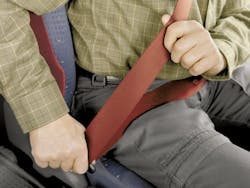“The numbers indicate a rise in truck occupant fatalities for the second straight year [and] my intuition tells me this is due in some part to drivers and others in the truck not wearing seat belts,” Keppler (seen at right) told me by email.
“Last year this was a significant contributor and I suspect we will see it again this year [as] the non-truck occupant deaths was also the reason for the majority of the increase,” he explained. “If you look at those fatalities, approximately half of them were not restrained.”
Keppler noted, too, that current regulations only require only the driver to be belted in the cab; not any passengers. “This is inexcusable,” he stressed. “There is no legitimate reason for drivers or occupants not to be belted.”
He added that data gathered by the Federal Motor Carrier Safety Administration (FMCSA) for its Large Truck Fatal Crash Data report back in 2011 indicated that 34% of truck occupants killed in crashes died because they weren’t wearing a seat belt. As a result, CVSA is pushing FMCSA to require that ALL occupants of the truck cab – driver and passenger alike – buckle up.Seat belt usage is not a new issue, of course: indeed, there have been numerous studies over the years advocating more “primary” laws be established on a state-by-state basis to make it mandatory for drivers of all vehicles to buckle up.
Yet NHTSA’s most recent safety data indicates buckling up may be suddenly slipping in the commercial truck world.
It’s also important to recognize, too, the human element in all of this as seat belts can oftentimes be uncomfortable to wear. Indeed, while it looks easy to do on paper, mandating seat belt usage is something else in the real world – as attempts to mandate seat belts for school buses proved a few years back.
Still, despite the possible recent setback, seat belt usage among truck drivers has been climbing significantly over the last 5 years – indeed, CVSA’s Keppler highlighted this very positive trend line three years ago. The question before us now, though, is can such high usage numbers be sustained? That’s the real trick when it comes to seat belt usage for the long haul.





